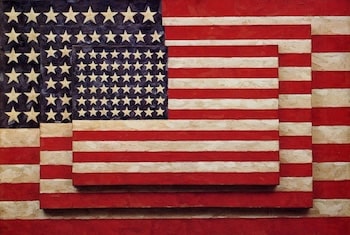Three Flags, 1958 by Jasper Johns

Johns' early style is perfectly exemplified by the lush reticence of the large monochrome White Flag of 1955. This painting was preceded by a red, white, and blue version, Flag (1954-55;
Museum of Modern Art New York), and followed by numerous drawings and prints of flags in various mediums. In 1958, Johns painted Three Flags (Whitney Museum of Art, New York), in which
three canvases are superimposed on one another in what appears to be reverse perspective, projecting toward the viewer. Here Johns superimposed three red, white, and blue flags so that the smallest is closest to the viewer.
The painting is five inches deep and has an objectlike quality. It shares with many works of art made since World War II the characteristic that it seems to invade the real space of the viewer.
The American flag subject is typical of Johns' use of quotidian imagery in the mid- to late 1950s. As he explained, the imagery derives from "things the mind already knows," utterly familiar icons such as flags, targets, stenciled
numbers, ale cans, and, slightly later, maps of the U.S.
It has been suggested that the American flag in Johns' work is an autobiographical reference, because a military hero after whom he was named, Sergeant William Jasper, raised the flag in a brave action during the Revolutionary War.
Because a flag is a flat object, it may signify flatness or the relative lack of depth in much modernist painting. The flag may of course function as an emblem of the United States and may in turn connote American art, Senator Joseph
McCarthy, or the Vietnam War, depending on the date of Johns' use of the image, the date of the viewer's experience of it, or the nationality of the viewer. Or the flag may connote none of these things. Used in Johns' recent work,
for example, The Seasons (Summer), an intaglio print of 1987, it seems inescapably to refer to his own art. In other words, the meaning of the flag in Johns' art suggests the extent to which the "meaning" of this subject matter
may be fluid and open to continual reinterpretation.
